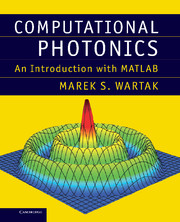Book contents
- Frontmatter
- Contents
- Preface
- 1 Introduction
- 2 Basic facts about optics
- 3 Basic facts from electromagnetism
- 4 Slab waveguides
- 5 Linear optical fibre and signal degradation
- 6 Propagation of linear pulses
- 7 Optical sources
- 8 Optical amplifiers and EDFA
- 9 Semiconductor optical amplifiers (SOA)
- 10 Optical receivers
- 11 Finite difference time domain (FDTD) formulation
- 12 Beam propagation method (BPM)
- 13 Some wavelength division multiplexing (WDM) devices
- 14 Optical link
- 15 Optical solitons
- 16 Solar cells
- 17 Metamaterials
- Appendix A Basic MATLAB
- Appendix B Summary of basic numerical methods
- Index
1 - Introduction
Published online by Cambridge University Press: 05 July 2013
- Frontmatter
- Contents
- Preface
- 1 Introduction
- 2 Basic facts about optics
- 3 Basic facts from electromagnetism
- 4 Slab waveguides
- 5 Linear optical fibre and signal degradation
- 6 Propagation of linear pulses
- 7 Optical sources
- 8 Optical amplifiers and EDFA
- 9 Semiconductor optical amplifiers (SOA)
- 10 Optical receivers
- 11 Finite difference time domain (FDTD) formulation
- 12 Beam propagation method (BPM)
- 13 Some wavelength division multiplexing (WDM) devices
- 14 Optical link
- 15 Optical solitons
- 16 Solar cells
- 17 Metamaterials
- Appendix A Basic MATLAB
- Appendix B Summary of basic numerical methods
- Index
Summary
In this introductory chapter we will try to define computational photonics and to position it within a broad field of photonics. We will briefly summarize several subfields of photonics (with the main emphasis on optical fibre communication) to indicate potential possibilities where computational photonics can significantly contribute by reducing cost of designing new devices and speeding up their development.
What is photonics?
We start our discussion from a broader perspective by articulating what photonics is, what the current activities are and where one can get the most recent information.
Photonics is the field which involves electromagnetic energy, such as light, where the fundamental object is a photon. In some sense, photonics is parallel to electronics which involves electrons. Photonics is often referred to as optoelectronics, or as electro-optics to indicate that both fields have a lot in common. In fact, there is a lot of interplay of photonics and electronics. For example, a laser is driven by electricity to produce light or to modulate that light to transmit data.
Photonics applications use the photon in a similar way to that which electronic applications use the electron. However, there are several advantages of optical transmission of data over electrical. Furthermore, photons do not interact between themselves (which is both good and bad), so electromagnetic beams can pass through each other without interacting and/or causing interference.
- Type
- Chapter
- Information
- Computational PhotonicsAn Introduction with MATLAB, pp. 1 - 16Publisher: Cambridge University PressPrint publication year: 2013



